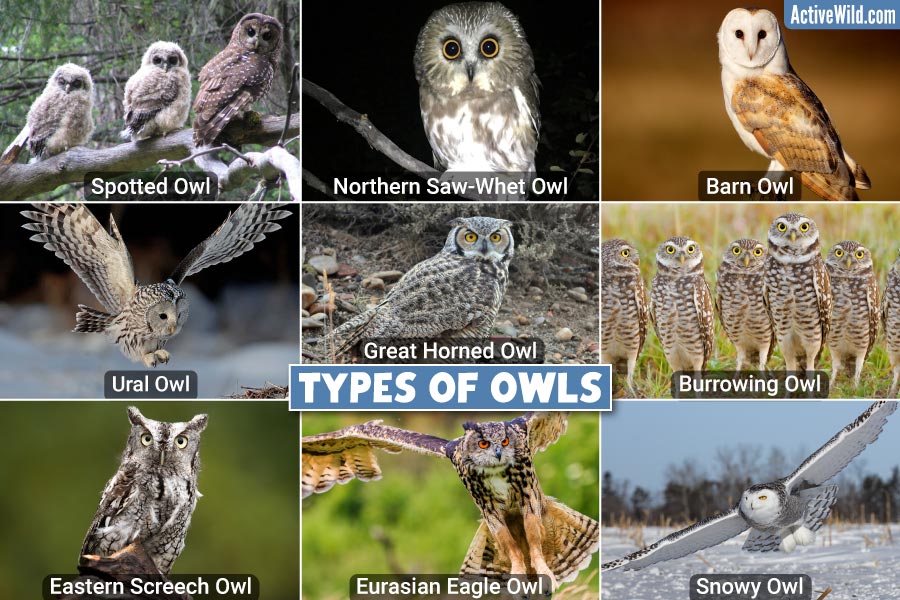Types of owls with pictures and facts. Owls are some of the most distinctive types of birds, and due to their nocturnal behavior and haunting calls are often featured in folklore and myths.
On this page is a list of different types of owls, featuring well-known and notable owl species. The IUCN conservation status (source) for each species has been provided, and is correct at the time of writing.
What Is An Owl?
Owls are nocturnal birds of prey known for their distinctive round faces, large forward-facing eyes, and the ability of some species to rotate their heads up to 270 degrees.
The 238 living species of owls (source) make up the order Strigiformes and are divided into two families: Strigidae (typical owls) and Tytonidae (barn owls).
Owls are found on every continent except Antarctica and have adapted to a variety of habitats, from dense forests to open grasslands.
These distinctive birds of prey have numerous adaptations for their nocturnal lifestyles. Their unique facial discs help channel sound to their ears, granting them exceptional hearing. This, combined with keen eyesight, makes them formidable hunters, primarily preying on small mammals, birds, and insects. Specialized feathers allow for silent flight, aiding them in stealthily approaching prey.
Owls play a crucial role in mythologies and cultures worldwide, often symbolizing wisdom, mystery, death, good–and bad–fortune in different parts of the world.
Different Types Of Owls
Australian Boobook

Scientific Name: Ninox boobook
Family: Strigidae
Continent(s) found: Australia
Typical Habitat: Forests, woodlands, and even urban settings
Wingspan: 0.7-0.9m (2.3-2.9ft)
Weight: 0.2-0.3 kg (0.44-0.66 lb)
IUCN conservation status: Least Concern
The Australian Boobook is Australia's smallest and most widespread owl species. Named for its characteristic 'boo-book' call, it primarily preys on insects and small vertebrates. Many Australians are familiar with its distinctive call during the night, especially in suburban areas.
Barn Owl
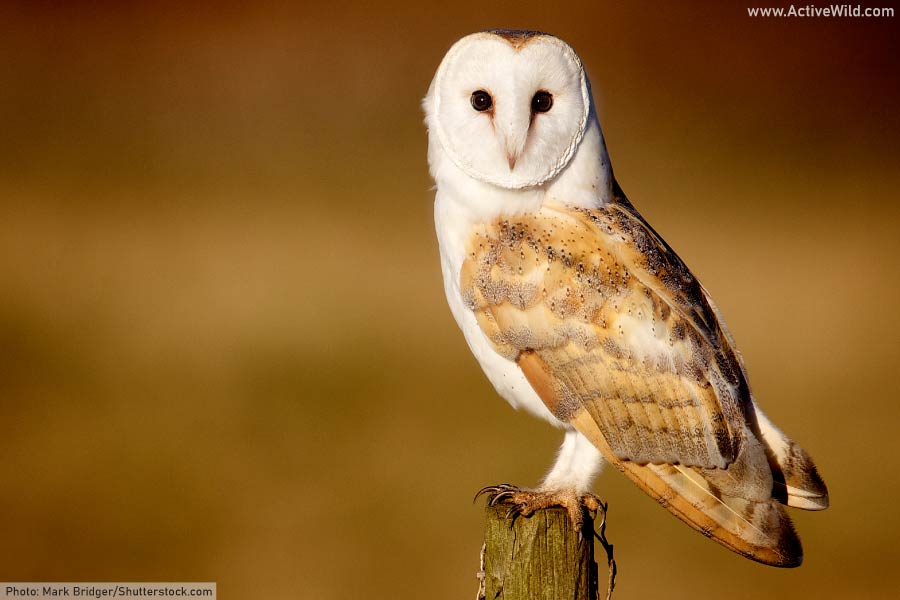
Scientific Name: Tyto alba
Family: Tytonidae
Continent(s) found: Almost worldwide (excluding some polar and desert regions)
Typical Habitat: Farmlands, grasslands, and woods
Wingspan: 0.8-1m (2.6-3.3ft)
Weight: 0.2-0.5 kg (0.44-1.1 lb)
IUCN conservation status: Least Concern
The Barn Owl's ghostly appearance and eerie, raspy calls have made it the subject of myths and legends in many parts of the world. Recognizable by its heart-shaped face and light-colored plumage, this owl is a stealthy hunter, primarily feeding on small rodents. The Barn Owl's excellent low-light vision and acute sense of hearing make it a formidable nocturnal predator.
The barn owl has a wider range than any other species of owl, being found on all continents except Antarctica.
Barred Owl

Scientific Name: Strix varia
Family: Strigidae
Continent(s) found: North America
Typical Habitat: Mature forests, especially near water
Wingspan: 0.9-1.1m (3-3.6ft)
Weight: 0.4-1 kg (0.88-2.2 lb)
IUCN conservation status: Least Concern
With its brown eyes and richly barred plumage, the Barred Owl is a charismatic species found throughout dense woodlands in North America. Its hooting call, "Who cooks for you, who cooks for you all.", is a classic sound in older forests, and has given the owl an alternative name of “hoot owl” or “eight hooter owl”.
The barred owl has a varied diet, including small mammals, birds, and amphibians.
In recent years, the barred owl’s range has begun to expand westwards, where its presence is thought to be detrimental to the threatened spotted owl.
Blakiston’s Fish Owl

Scientific Name: Ketupa blakistoni
Family: Strigidae
Continent(s) found: Asia (Russia, China, Japan, North Korea)
Typical Habitat: Dense riparian forests
Wingspan: 1.78-2m (5.8-6.6ft)
Weight: 2-3 kg (4.4-6.6 lb)
IUCN conservation status: Endangered
The world's largest species of owl, Blakiston's Fish Owl is adapted to hunt in aquatic habitats. Its preferred meals include fish and other aquatic creatures. This owl is under threat due to habitat loss, especially the loss of old-growth trees that it requires for nesting, and the degradation of river ecosystems.
Despite its name, Blakiston's Fish Owl is more closely related to the Eurasian eagle owl than it is to other fish owls of genus Ketupa.
Boreal Owl

Scientific Name: Aegolius funereus
Family: Strigidae
Continent(s) found: North America, Europe, and Asia
Typical Habitat: Boreal and mountainous forests
Wingspan: 0.6-0.7m (1.9-2.3ft)
Weight: 0.1-0.3 kg (0.22-0.66 lb)
IUCN conservation status: Least Concern
A secretive and seldom-seen owl, the Boreal Owl thrives in dense coniferous forests. This small owl has a distinctive rounded head, lacking ear tufts.
The species primarily feeds on small mammals, especially voles, and has a soft, haunting, trill-like call that can carry for long distances on calm nights during the breeding season. Its plumage provides excellent camouflage against the bark of trees.
Burrowing Owl

Scientific Name: Athene cunicularia
Family: Strigidae
Continent(s) found: Americas
Typical Habitat: Grasslands, rangelands, agricultural areas, deserts
Wingspan: 0.5-0.6m (1.6-2ft)
Weight: 0.14-0.24 kg (0.31-0.53 lb)
IUCN conservation status: Least Concern
Unlike most owls, this small species is often active during the day. It lives in burrows, often ones dug by prairie dogs or other burrowing animals. The species has a varied diet, which includes insects, small rodents, and other birds.
Eastern Screech-Owl

Scientific Name: Megascops asio
Family: Strigidae
Continent(s) found: North America
Typical Habitat: Woodlands, forests, suburban and urban areas
Wingspan: 0.5-0.6m (1.6-2ft)
Weight: 0.12-0.3 kg (0.26-0.66 lb)
IUCN conservation status: Least Concern
This small owl is found in a wide range of habitats, including woodlands, forests, and urban areas. The species has two main color variations, or “morphs”: a red, or rufus, morph, and a gray morph.
The eastern screech owl has a trilling call, which is often heard at night, especially during the breeding season. It is found across eastern North America, and is closely related to the western screech owl, which is found in the western half of the continent.
Elf Owl

Scientific Name: Micrathene whitneyi
Family: Strigidae
Continent(s) found: North America (Southwestern United States, Mexico)
Typical Habitat: Desert, thorn scrub, and woodlands
Wingspan: 0.27-0.31m (0.89-1.02ft)
Weight: 0.04-0.09 kg (0.088-0.198 lb)
IUCN conservation status: Least Concern
The elf owl is the smallest owl in the world, being only slightly heavier than a house sparrow. The species nests in old woodpecker holes in saguaro cacti or trees, and feeds primarily on insects and arachnids.
Eurasian Eagle-Owl

Scientific Name: Bubo bubo
Family: Strigidae
Continent(s) found: Europe and Asia
Typical Habitat: Mountains, forests, and grasslands
Wingspan: 1.3-1.8m (4.3-5.9ft)
Weight: 1.5-4 kg (3.3-8.8 lb)
IUCN conservation status: Least Concern
The Eurasian Eagle-Owl is one of the largest and most powerful owls in the world. Native to Europe and Asia, this impressive bird possesses distinctive large, orange eyes, tufted "ear" feathers, and a mix of mottled brown, black, and cream plumage.
The species is found in a variety of habitats, from mountainous landscapes to dense forests. With a wingspan often exceeding 6 feet, the Eurasian Eagle-Owl primarily preys on mammals, birds, and other sizeable prey, even capturing animals as large as small deer or foxes on occasion. Its deep, resonating call is unmistakable in its native habitats.
Ferruginous Pygmy-Owl

Scientific Name: Glaucidium brasilianum
Family: Strigidae
Continent(s) found: Americas
Typical Habitat: Woodlands, forests, and savannahs
Wingspan: 0.38-0.42m (1.25-1.38ft)
Weight: 0.06-0.08 kg (0.13-0.18 lb)
IUCN conservation status: Least Concern
The Ferruginous Pygmy-Owl is a small owl native to the Americas, found from the southern parts of the United States through Central America to parts of South America. It inhabits a variety of environments, from arid scrublands to tropical forests.
Despite its diminutive size, often no larger than a sparrow, the Ferruginous Pygmy-Owl is a fierce predator, preying on insects, birds, and small mammals.
The species is characterized by its rusty-brown plumage, long tail, and yellow eyes. A distinctive feature is the presence of two black "eye spots" on the back of its head, which can mislead potential predators into thinking it's always watching.
The Ferruginous Pygmy-Owl’s call is a series of rapid, high-pitched whistles.
Flammulated Owl

Scientific Name: Psiloscops flammeolus
Family: Strigidae
Continent(s) found: North America
Typical Habitat: Mountainous pine and fir forests
Wingspan: 0.4-0.44m (1.31-1.44ft)
Weight: 0.045-0.065 kg (0.099-0.143 lb)
IUCN conservation status: Least Concern
The Flammulated Owl is a small, nocturnal owl native to mountainous woodlands of North America.
Distinguished by its dark eyes and cryptic plumage, the Flammulated Owl’s name derives from the flame-like markings on its face and body. It measures just about 6 inches in length, making it one of North America’s smallest owls.
Primarily insectivorous, the Flammulated Owl preys on moths, beetles, and other insects. Its soft, low hooting calls can be a challenge to detect, blending seamlessly with the sounds of the forest night. This elusive owl’s mottled gray and brown feathers provide excellent camouflage against tree bark, making it often hard to spot.
Great Gray Owl

Scientific Name: Strix nebulosa
Family: Strigidae
Continent(s) found: North America, Europe, and Asia
Typical Habitat: Boreal forests and mountain meadows
Wingspan: 1.3-1.5m (4.2-4.9ft)
Weight: 0.7-1.3 kg (1.5-2.9 lb)
IUCN conservation status: Least Concern
The Great Gray Owl is one of the world's largest owls by length, though much of its size is an illusion created by its thick feathers.
Native to the boreal forests of North America and Eurasia, this majestic bird is recognized by its striking, rounded face, concentric rings surrounding its yellow eyes, and long tail. Its facial disk is the largest of any owl.
The Great Gray Owl’s muted gray and white plumage allows it to blend seamlessly with its wintry surroundings. Sometimes described as a "phantom of the north," the Great Gray Owl silently hunts small mammals, especially voles, by hovering over snow before plunging down to capture its prey. Its distinct deep hoots resonate through its cold, forested habitats.
Great Horned Owl
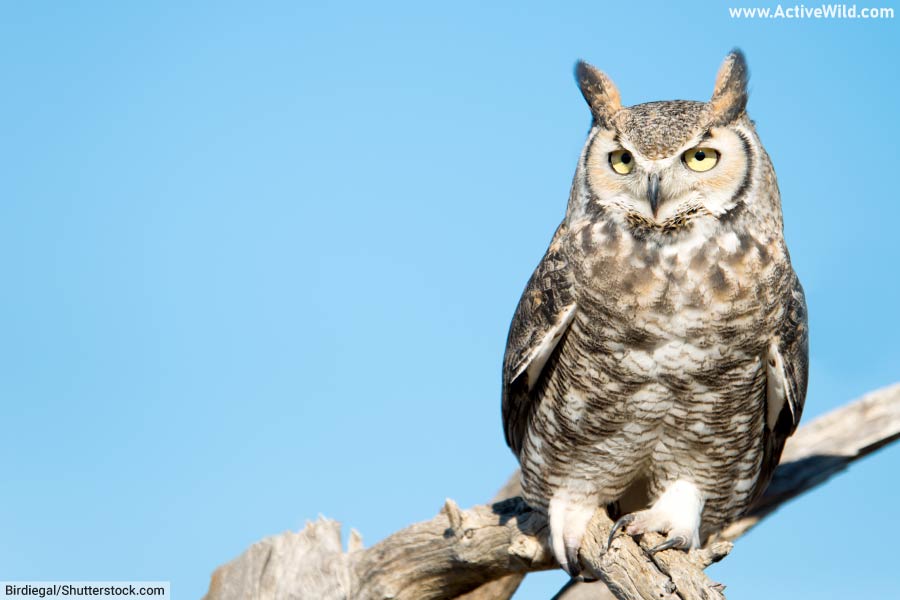
Scientific Name: Bubo virginianus
Family: Strigidae
Continent(s) found: Americas (from Arctic to South America)
Typical Habitat: Forests, swamps, deserts, and urban areas
Wingspan: 1.1-1.5m (3.3-4.8ft)
Weight: 0.9-2.5 kg (2-5.5 lb)
IUCN conservation status: Least Concern
The Great Horned Owl is a robust and versatile bird of prey found throughout the Americas, from Arctic tundra to tropical rainforests. Recognizable by its tufted "horns" or "ear tufts" and large yellow eyes set in a deeply feathered face, its body is mottled with a mix of browns, whites, and blacks. The species has a deep, resonating hoot that is iconic in its habitats, often being heard during dusk or dawn.
Often dubbed the "tiger of the skies," the great horned owl is a formidable hunter, preying on a diverse range of animals, from birds and rodents to larger prey like rabbits. Its diet includes several other species of birds of prey.
The Great Horned Owl is known for its adaptability, capable of nesting in a variety of locations, and its ability to take over other birds' nests, particularly those of Red-tailed Hawks.
Long-Eared Owl
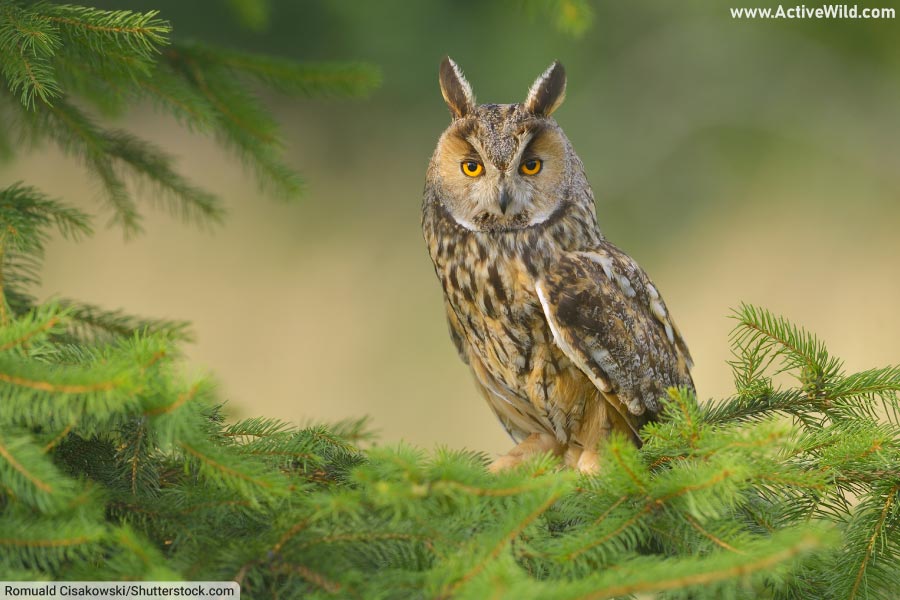
Scientific Name: Asio otus
Family: Strigidae
Continent(s) found: North America, Europe, and Asia
Typical Habitat: Forests, woodlands, and grasslands, often near open areas.
Wingspan: 0.9-1m (2.9-3.3ft)
Weight: 0.2-0.4 kg (0.44-0.88 lb)
IUCN conservation status: Least Concern
This medium-sized owl possesses elongated ear tufts that stand tall when the owl is alarmed. It is cryptically colored, with mottled brown feathers, helping it blend with tree bark. The species is nocturnal and migratory. Its diet mainly consists of small mammals and birds.
Northern Hawk Owl

Scientific Name: Surnia ulula
Family: Strigidae
Continent(s) found: North America, Europe, and Asia
Typical Habitat: Taiga, boreal forests, and open timber areas
Wingspan: 0.7-1m (2.3-3.3ft)
Weight: 0.3-0.4 kg (0.66-0.88 lb)
IUCN conservation status: Least Concern
Unlike most other owls, the northern hawk owl is only active during the day. Named for its hawk-like behavior and appearance, the northern hawk owl has a long tail and wings, with a rounded head and no ear tufts. Its mottled brown and white plumage provides camouflage against tree bark.
Northern Pygmy-Owl

Scientific Name: Glaucidium gnoma
Family: Strigidae
Continent(s) found: North America
Typical Habitat: Mountainous forests and woodlands
Wingspan: 0.38-0.41m (1.25-1.35ft)
Weight: 0.06-0.07 kg (0.13-0.15 lb)
IUCN conservation status: Least Concern
A diminutive owl, the northern pygmy owl is active both during the day and night. The species is recognizable by its rounded head, lack of ear tufts, and false "eye" spots on the back of its head.
Despite its small size, the northern pygmy owl is an aggressive hunter, preying on birds and small mammals.
Northern Saw-Whet Owl

Scientific Name: Aegolius acadicus
Family: Strigidae
Continent(s) found: North America
Typical Habitat: Dense coniferous or mixed woodlands
Wingspan: 0.42-0.56m (1.38-1.84ft)
Weight: 0.06-0.11 kg (0.13-0.24 lb)
IUCN conservation status: Least Concern
This tiny owl has a cat-like face, large head, and bright yellow eyes. It's named after the "saw-whetting" sound it makes, which is similar to a saw being sharpened. It mostly hunts small mammals such as voles and mice.
Oriental Bay Owl
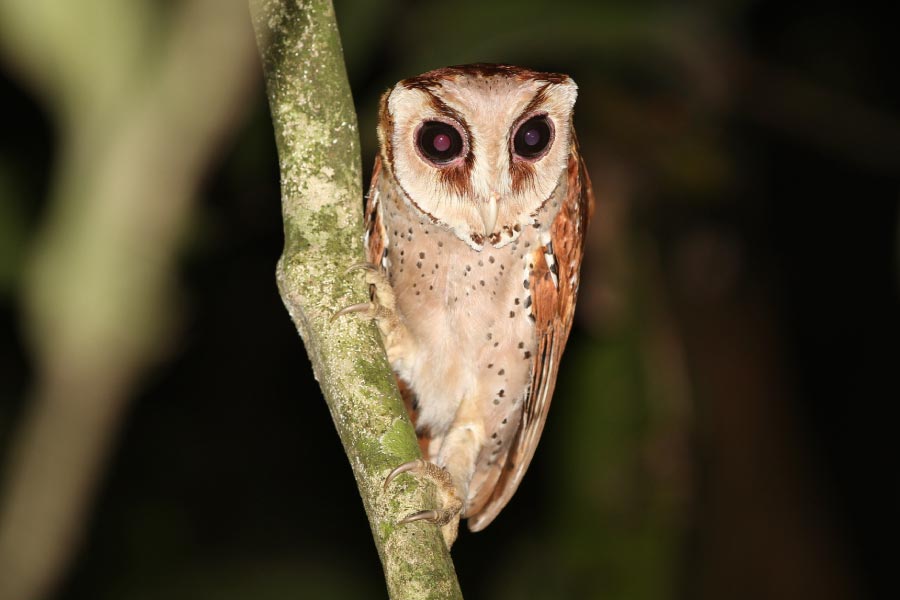
Scientific Name: Phodilus badius
Family: Tytonidae
Continent(s) found: Southeast Asia
Typical Habitat: Forests and dense woodlands
Wingspan: 0.68-0.92m (2.2-3ft)
Weight: 0.2-0.27 kg (0.44-0.6 lb)
IUCN conservation status: Least Concern
The oriental bay owl, like its relative the Sri Lanka bay owl, is highly distinctive due to its heart-shaped facial disc, and large, black eyes. The two bay owls, which together make up the genus Phodilus, are typically smaller than the other members of the barn owl family, Tytonidae.
Powerful Owl

Scientific Name: Ninox strenua
Family: Strigidae
Continent(s) found: Australia
Typical Habitat: Forests and woodlands
Wingspan: 1.1-1.4m (3.6-4.6ft)
Weight: 1-2.5 kg (2.2-5.5 lb)
IUCN conservation status: Least Concern
The powerful owl is the largest owl species in Australia, and is named for its impressive hunting capabilities. Armed with powerful talons, it can prey on animals as large as possums. The species is recognizable by its size, large orange-yellow eyes, and relatively small head and long tail, which give the owl a hawk-like appearance.
Short-Eared Owl

Scientific Name: Asio flammeus
Family: Strigidae
Continent(s) found: Worldwide (except Antarctica and Australia)
Typical Habitat: Open areas like grasslands, marshes, and tundras
Wingspan: 0.95-1.1m (3.1-3.6ft)
Weight: 0.2-0.5 kg (0.44-1.1 lb)
IUCN conservation status: Least Concern
Named for its ear-like short tufts of feathers (which are often hard to see), the short-eared owl is mostly nocturnal but can also be seen hunting during the day, especially in winter. It has a distinctive flight pattern with stiff wingbeats and long glides. This species, which is found in the Americas and Eurasia, primarily feeds on small mammals and birds.
Snowy Owl

Scientific Name: Bubo scandiacus
Family: Strigidae
Continent(s) found: North America, Europe, and Asia (arctic regions)
Typical Habitat: Arctic tundras
Wingspan: 1.3-1.5m (4.2-4.9ft)
Weight: 1.6-3 kg (3.5-6.6 lb)
IUCN conservation status: Vulnerable
The Snowy Owl is a distinctive white owl native to the Arctic regions. It's well-known for its striking appearance: males can be almost pure white, while females have more flecks of black.
Snowy Owls are diurnal, meaning they hunt both day and night, preying mainly on lemmings and other small mammals.
The population of snowy owls can fluctuate significantly based on prey availability; a successful breeding year can result in snowy owls migrating to regions in which they are not usually found, including southern states such as Florida.
Spectacled Owl
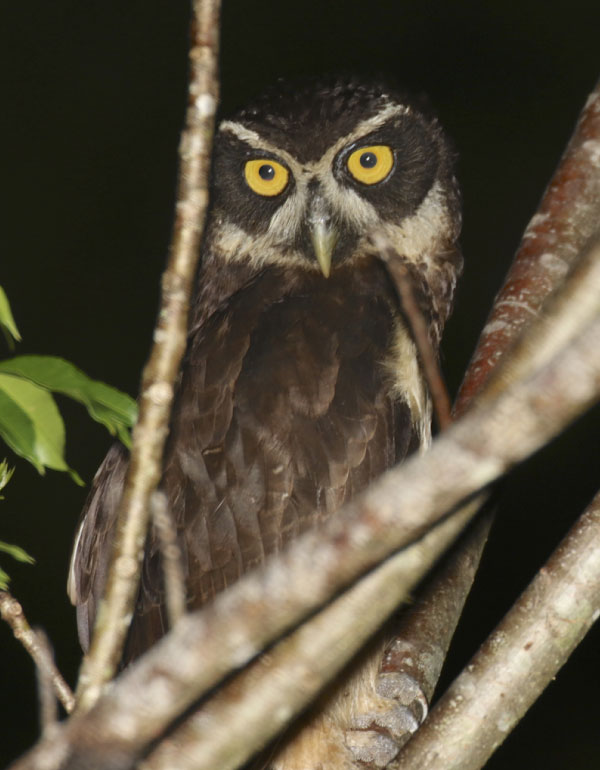
Scientific Name: Pulsatrix perspicillata
Family: Strigidae
Continent(s) found: Central and South America
Typical Habitat: Tropical rainforests
Wingspan: 0.8-1m (2.6-3.3ft)
Weight: 0.5-0.9 kg (1.1-2 lb)
IUCN conservation status: Least Concern
The Spectacled Owl is a large, striking bird found in the tropical forests of Central and South America. Named for its distinctive facial appearance, it boasts bold, white "eyebrow" rings and a black "mask" around its yellow eyes, giving it a bespectacled look. The rest of its body features dark brown plumage with lighter underparts.
This nocturnal predator primarily hunts mammals, birds, and large insects. Its eerie, pulsing calls can be heard echoing through the rainforest at night.
Despite its size and prominent features, the Spectacled Owl's cryptic coloring allows it to blend into its forested environment.
Spotted Owl
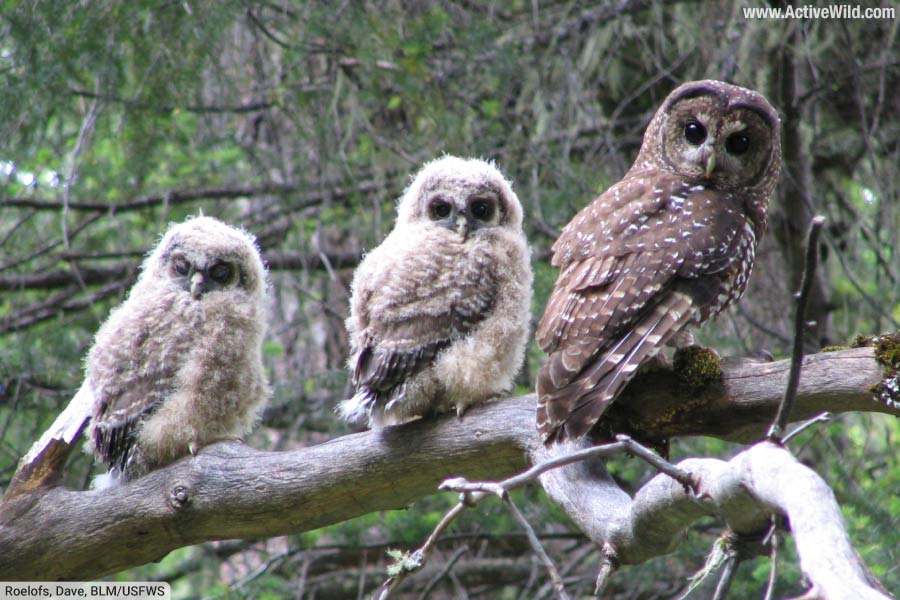
Scientific Name: Strix occidentalis
Family: Strigidae
Continent(s) found: North America
Typical Habitat: Old-growth forests
Wingspan: 1-1.2m (3.3-3.9ft)
Weight: 0.4-0.7 kg (0.88-1.5 lb)
IUCN conservation status: Near Threatened
The Spotted Owl is mottled brown with white spots and a barred belly. It is closely associated with ancient, old-growth forests, making habitat destruction a significant threat to its survival. This species has been at the center of many conservation debates due to its sensitivity to habitat changes, especially logging activities.
Tawny Owl

Scientific Name: Strix aluco
Family: Strigidae
Continent(s) found: Europe and Asia
Typical Habitat: Forests and woodlands
Wingspan: 0.9-1.1m (2.9-3.6ft)
Weight: 0.4-0.8 kg (0.88-1.76 lb)
IUCN conservation status: Least Concern
The Tawny Owl is a stocky, medium-sized owl known for its characteristic call that sounds like "twit-twoo." It has a rufous-brown body with a paler underside and dark streaks. The Tawny Owl is nocturnal, hunting mostly rodents and small birds.
The tawny owl hunts mainly by sound. Its hearing is ten times more sensitive than a human’s. The noise disturbance caused by rain can prevent the owl from being able to hunt.
The species is sedentary, often staying in the same territory throughout its life.
Ural Owl
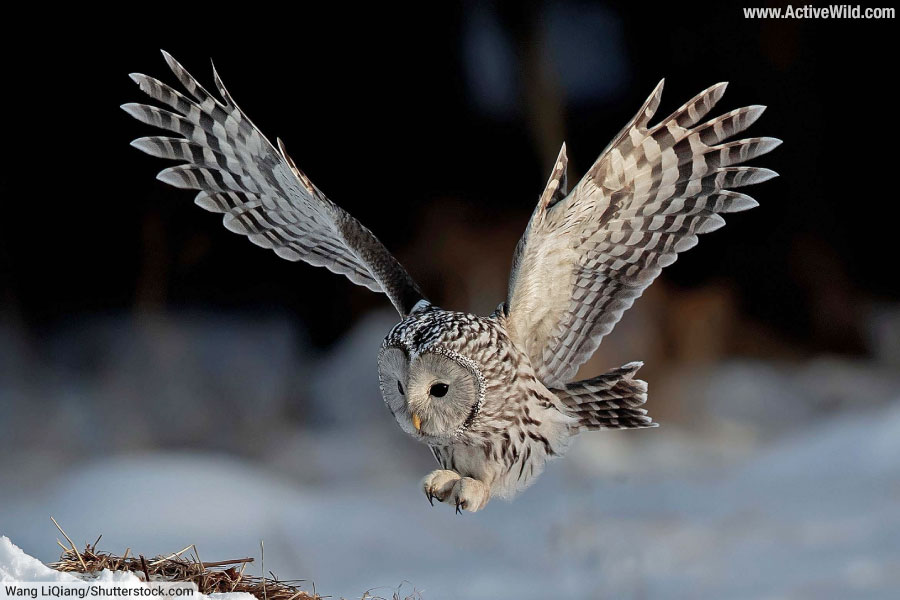
Scientific Name: Strix uralensis
Family: Strigidae
Continent(s) found: Europe and Asia
Typical Habitat: Forests and woodlands
Wingspan: 1.1-1.4m (3.6-4.6ft)
Weight: 0.5-1 kg (1.1-2.2 lb)
IUCN conservation status: Least Concern
The Ural Owl is a medium-to-large owl predominantly found in the forests of northern Europe and Asia. It has a pale face with dark eyes, and a grayish body adorned with white and dark streaks. It lacks ear tufts and has a round head and a slightly elongated tail.
The Ural Owl is primarily a nocturnal hunter, preying on small mammals, birds, and sometimes amphibians and insects. Its haunting, rhythmic hoot can often be heard during the twilight hours.
Preferring dense, mature forests with clearings, the Ural Owl nests in tree cavities and is known for its territorial nature, especially during the breeding season. A female Ural owl is extremely protective of her nest, and the species has been known to inflict serious injuries on humans perceived as a threat.
Discover More With Active Wild
You can find out more about birds on this page: Birds – The Ultimate Guide
Discover different types of birds on this page: Types of Birds
Visit our main animals page for links to animal information and a complete guide to the animal kingdom: Animals

